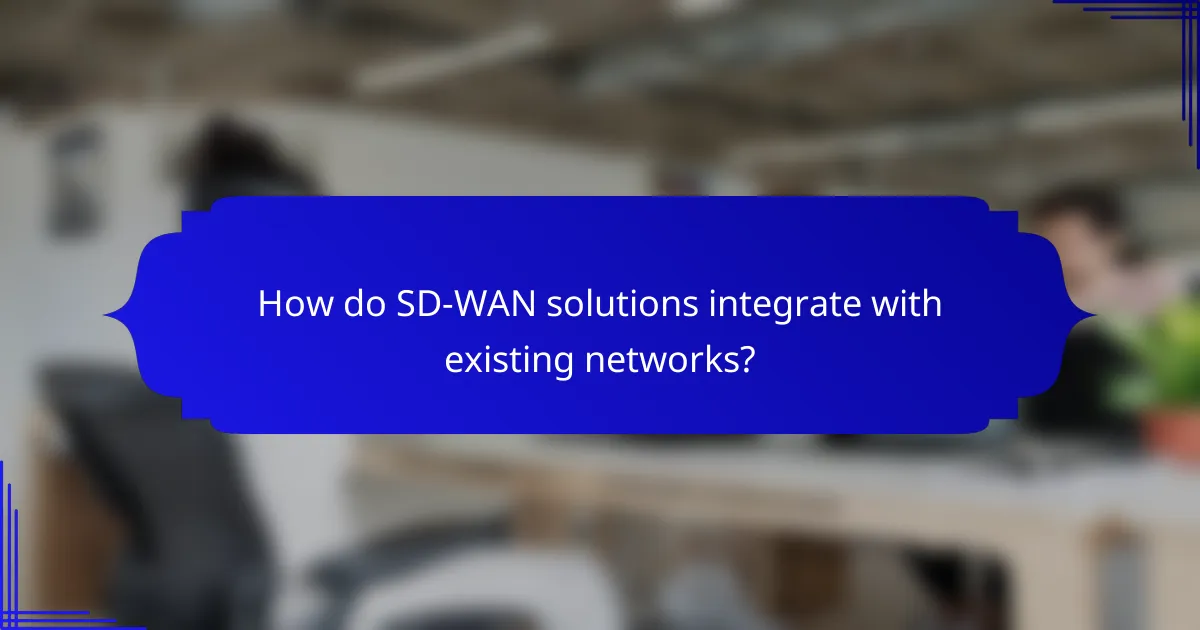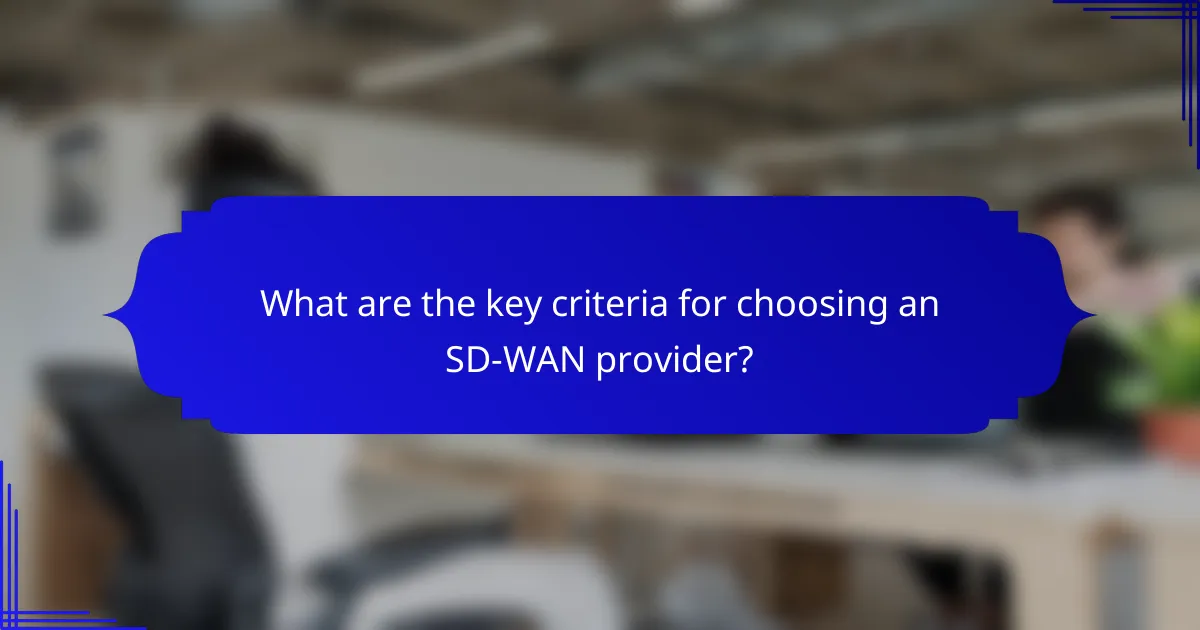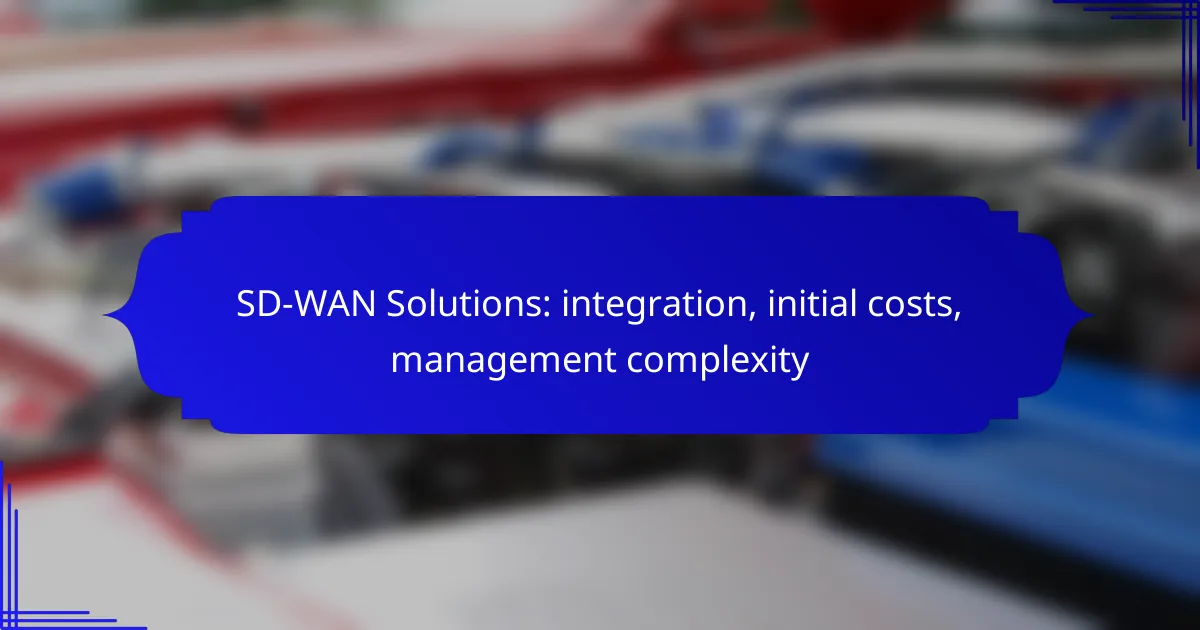SD-WAN solutions offer New Zealand businesses a way to enhance network performance while reducing costs through integration with existing infrastructures. By leveraging software-defined networking principles, these solutions optimize connectivity and application performance, making them a viable alternative to traditional WAN technologies. However, organizations should be prepared for varying initial costs associated with hardware, software, and ongoing management expenses as they transition to this advanced networking approach.

What are the best SD-WAN solutions for New Zealand businesses?
New Zealand businesses can benefit from several leading SD-WAN solutions that enhance network performance and reduce costs. Key players include Cisco, VMware, Silver Peak, Fortinet, and Oracle, each offering unique features tailored to different business needs.
Cisco SD-WAN
Cisco SD-WAN provides robust security and seamless integration with existing Cisco infrastructure. It offers centralized management, allowing businesses to monitor and optimize their networks efficiently.
Consider Cisco if your organization already uses Cisco products, as this can simplify deployment and management. The solution is particularly effective for enterprises with multiple locations across New Zealand, ensuring reliable connectivity and performance.
VMware SD-WAN
VMware SD-WAN focuses on delivering high performance and flexibility for cloud applications. Its architecture allows for easy integration with various cloud services, making it ideal for businesses transitioning to cloud-based operations.
This solution is suitable for companies looking to enhance their application performance while maintaining control over their network. VMware’s emphasis on analytics can help businesses in New Zealand make informed decisions about their network usage and costs.
Silver Peak SD-WAN
Silver Peak SD-WAN emphasizes optimizing WAN performance through advanced techniques like dynamic path control. It is designed to improve application performance and reduce latency, which is crucial for businesses relying on real-time data.
This solution is particularly beneficial for organizations with high bandwidth demands or those operating in remote areas of New Zealand, where connectivity can be challenging. Silver Peak’s focus on user experience can help businesses enhance productivity and customer satisfaction.
Fortinet Secure SD-WAN
Fortinet Secure SD-WAN combines security features with SD-WAN capabilities, providing a comprehensive solution for businesses concerned about cybersecurity. Its integrated firewall and threat protection help safeguard data across the network.
For New Zealand businesses prioritizing security, Fortinet offers a compelling option. Its ability to simplify network management while enhancing security can be a significant advantage for organizations in regulated industries.
Oracle SD-WAN
Oracle SD-WAN is designed for enterprises that require high availability and reliability, particularly in mission-critical applications. Its integration with Oracle Cloud services makes it a strong choice for businesses using Oracle products.
Companies in New Zealand leveraging Oracle’s ecosystem will find this solution beneficial for ensuring optimal performance and connectivity. The focus on enterprise-grade features can help organizations manage their networks effectively while minimizing downtime.

How do SD-WAN solutions integrate with existing networks?
SD-WAN solutions integrate with existing networks by leveraging software-defined networking principles to enhance connectivity and performance. They can work alongside traditional WAN technologies, enabling organizations to optimize their network traffic and improve application performance without extensive hardware changes.
Seamless integration with MPLS
SD-WAN can seamlessly integrate with MPLS (Multiprotocol Label Switching) networks, allowing businesses to maintain their existing MPLS infrastructure while enhancing flexibility and cost-effectiveness. By routing traffic dynamically based on real-time conditions, SD-WAN can optimize MPLS usage and reduce latency for critical applications.
Organizations should assess their current MPLS contracts and consider how SD-WAN can complement or replace certain MPLS paths. This hybrid approach often results in lower operational costs and improved bandwidth utilization.
Support for hybrid cloud environments
SD-WAN solutions are particularly beneficial for hybrid cloud environments, where businesses use a mix of on-premises and cloud-based resources. They facilitate secure and efficient connections to multiple cloud services, ensuring that data flows smoothly between local and cloud applications.
When implementing SD-WAN in a hybrid cloud setup, organizations should evaluate their cloud service providers and ensure that the SD-WAN can effectively manage traffic across different platforms. This may involve setting policies that prioritize critical applications and optimize bandwidth usage based on application needs.

What are the initial costs of implementing SD-WAN?
The initial costs of implementing SD-WAN can vary significantly based on the chosen solution and the scale of deployment. Generally, organizations should expect to invest in both hardware and software, along with potential ongoing expenses for management and support.
Cost breakdown for hardware and software
When considering SD-WAN, the hardware costs typically include routers, switches, and any necessary appliances. Software expenses usually encompass licensing fees for the SD-WAN platform and any additional security features.
For a small to medium-sized business, initial hardware costs can range from a few thousand to tens of thousands of dollars, depending on the complexity of the network. Software licensing can add several hundred to several thousand dollars annually, depending on the provider and features selected.
Monthly subscription models
Many SD-WAN solutions operate on a subscription model, which can help spread costs over time. Monthly fees often include access to the software, updates, and support services.
These subscription costs can vary widely, typically ranging from $500 to $5,000 per month based on the number of sites and bandwidth requirements. Organizations should evaluate their expected usage to choose a plan that fits their needs without overspending.
Potential hidden costs
While planning for SD-WAN, it’s crucial to consider hidden costs that might arise. These can include expenses for additional bandwidth, integration with existing systems, and ongoing management or training for staff.
Organizations may also face costs related to network downtime during the transition to SD-WAN or potential fees for exceeding data limits. Conducting a thorough cost analysis before implementation can help identify and mitigate these potential expenses.

What is the management complexity of SD-WAN?
The management complexity of SD-WAN can vary significantly based on the deployment model and the tools used. While SD-WAN solutions often simplify network management through automation and centralized control, they can also introduce challenges related to configuration, monitoring, and troubleshooting.
Centralized management platforms
Centralized management platforms are a key feature of SD-WAN solutions, allowing administrators to control multiple sites from a single interface. This can streamline operations by enabling consistent policy application and configuration across the network. However, the initial setup can be complex, requiring a thorough understanding of both the SD-WAN technology and the specific needs of the organization.
When selecting a centralized management platform, consider factors such as user interface intuitiveness, integration capabilities with existing systems, and the level of support provided by the vendor. A well-chosen platform can significantly reduce ongoing management complexity.
Ease of monitoring and troubleshooting
Monitoring and troubleshooting in an SD-WAN environment can be simplified through built-in analytics and reporting tools. These tools provide real-time visibility into network performance, helping to identify issues quickly. However, the effectiveness of these tools depends on proper configuration and the ability to interpret the data accurately.
To enhance monitoring and troubleshooting, ensure that alerts are set up for critical performance metrics and that staff are trained to use the analytics tools effectively. Regularly reviewing network performance reports can also help preemptively address potential issues before they escalate.

What are the key criteria for choosing an SD-WAN provider?
When selecting an SD-WAN provider, consider performance, reliability, customer support, and service agreements. These criteria will ensure that the solution meets your organization’s needs and expectations effectively.
Performance and reliability metrics
Performance and reliability metrics are crucial for assessing an SD-WAN provider. Look for solutions that offer low latency, high availability, and consistent throughput. A reliable SD-WAN should maintain performance across various network conditions and provide redundancy to minimize downtime.
Common metrics to evaluate include jitter, packet loss, and mean time to repair (MTTR). Aim for jitter levels below 30 ms and packet loss rates under 1% for optimal user experience. Providers that offer real-time monitoring tools can help track these metrics effectively.
Customer support and service level agreements
Customer support and service level agreements (SLAs) are vital for ensuring smooth operations with your SD-WAN provider. Evaluate the support options available, such as 24/7 assistance, dedicated account managers, and online resources. A strong support system can significantly reduce resolution times for any issues that arise.
Review the SLAs for uptime guarantees and response times. A good SLA should promise at least 99.9% uptime and specify response times for critical issues, typically within a few hours. Understanding these commitments will help you gauge the provider’s reliability and accountability.

How does SD-WAN impact network security?
SD-WAN enhances network security by centralizing control and enabling secure connections across various locations. It employs encryption and segmentation to protect data while optimizing traffic flow.
Integration with existing security measures
Integrating SD-WAN with existing security measures is crucial for maintaining a robust security posture. Many SD-WAN solutions offer built-in security features such as firewalls, intrusion detection systems, and secure web gateways. This integration allows organizations to streamline their security protocols while ensuring comprehensive protection.
Initial costs and budgeting considerations
The initial costs of implementing SD-WAN can vary significantly based on the chosen solution and the scale of deployment. Organizations should budget for hardware, software, and potential training expenses. It’s advisable to consider both upfront and ongoing costs, as well as potential savings from reduced WAN expenses over time.
Management complexity and operational efficiency
While SD-WAN simplifies network management through centralized control, it can introduce complexity in terms of configuration and monitoring. Organizations should invest in training for IT staff to effectively manage the new system. Additionally, leveraging automated tools can enhance operational efficiency and reduce the burden of manual oversight.
